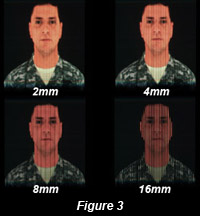We propose a new type of autostereoscopic light field display where the viewer looks directly into a dense array of video projectors. Unlike other projector array displays, each projector acts as one angularly varying pixel, so the display's spatial resolution depends on the number of video projectors and the angular resolution depends on the pixel resolution of any one video projector. Full horizontal and vertical parallax can be recreated with a two-dimensional projector layout (see Figure 1) or horizontal-only parallax can be created with a one-dimensional projector array and a vertical diffusing screen. An ideal display would avoid the need for horizontal diffusion through its sheer number of video projectors.

We determined the minimal density at which the projector pixels appear continuous. We note that a large horizontal array of pico-projectors can be simulated using a single projector, a mechanical translation stage, and long exposure photography. During each camera exposure, we translate the projector through all possible projector positions while rendering corresponding views of the virtual scene. The resulting photograph is equivalent to having an entire set of projectors illuminated simultaneously. For our experiments, we used a Texas Instruments Pico Development Kit with a 480x360 HVGA resolution. We then discretely sampled the projector arc at multiple densities including 2mm, 4mm, 8mm, and 16mm between projectors.

As seen in Figure 3, the 4mm and 2mm spacing approximates a continuous image. To physically construct a full display with 4mm projector spacing requires practical solutions for mounting and controlling such a large number of projectors. While the TI Pico projector has a thickness of 14mm, the projectors can be arranged in multiple rows to achieve the desired spacing (see Figure 2). 4mm spacing provides 200 positions over 80 cm. Feeding imagery to all 200 480x320 pixel projectors requires 30.7 megapixels to be rendered. This is a significant number, but is well within the capabilities of current graphics hardware. To test the depth of field of the display, we also incorporated foreground and background elements where the brick wall is 120cm behind the human model and the teapot is 20cm in front of the human model (Figure 4). Even at this distance from the screen, the objects maintain resolution and sharpness. Based on these findings, the path is clear to physically realize a horizontal parallax 1D array with currently available hardware. As projectors continue to shrink in size and price, such displays could evolve into full-parallax systems with arbitrarily high spatial and angular resolution.